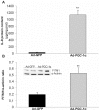PGC-1α induces mitochondrial and myokine transcriptional programs and lipid droplet and glycogen accumulation in cultured human skeletal muscle cells
- PMID: 22272266
- PMCID: PMC3260188
- DOI: 10.1371/journal.pone.0029985
PGC-1α induces mitochondrial and myokine transcriptional programs and lipid droplet and glycogen accumulation in cultured human skeletal muscle cells
Abstract
The transcriptional coactivator peroxisome proliferator-activated receptor-gamma coactivator 1 alpha (PGC-1α) is a chief activator of mitochondrial and metabolic programs and protects against atrophy in skeletal muscle (skm). Here we tested whether PGC-1α overexpression could restructure the transcriptome and metabolism of primary cultured human skm cells, which display a phenotype that resembles the atrophic phenotype. An oligonucleotide microarray analysis was used to reveal the effects of PGC-1α on the whole transcriptome. Fifty-three different genes showed altered expression in response to PGC-1α: 42 upregulated and 11 downregulated. The main gene ontologies (GO) associated with the upregulated genes were mitochondrial components and processes and this was linked with an increase in COX activity, an indicator of mitochondrial content. Furthermore, PGC-1α enhanced mitochondrial oxidation of palmitate and lactate to CO(2), but not glucose oxidation. The other most significantly associated GOs for the upregulated genes were chemotaxis and cytokine activity, and several cytokines, including IL-8/CXCL8, CXCL6, CCL5 and CCL8, were within the most highly induced genes. Indeed, PGC-1α highly increased IL-8 cell protein content. The most upregulated gene was PVALB, which is related to calcium signaling. Potential metabolic regulators of fatty acid and glucose storage were among mainly regulated genes. The mRNA and protein level of FITM1/FIT1, which enhances the formation of lipid droplets, was raised by PGC-1α, while in oleate-incubated cells PGC-1α increased the number of smaller lipid droplets and modestly triglyceride levels, compared to controls. CALM1, the calcium-modulated δ subunit of phosphorylase kinase, was downregulated by PGC-1α, while glycogen phosphorylase was inactivated and glycogen storage was increased by PGC-1α. In conclusion, of the metabolic transcriptome deficiencies of cultured skm cells, PGC-1α rescued the expression of genes encoding mitochondrial proteins and FITM1. Several myokine genes, including IL-8 and CCL5, which are known to be constitutively expressed in human skm cells, were induced by PGC-1α.
Conflict of interest statement
Figures






References
-
- Puigserver P, Spiegelman BM. Peroxisome proliferator-activated receptor-gamma coactivator 1 alpha (PGC-1 alpha): transcriptional coactivator and metabolic regulator. Endocr Rev. 2003;24:78–90. - PubMed
-
- Olesen J, Kiilerich K, Pilegaard H. PGC-1alpha-mediated adaptations in skeletal muscle. Pflugers Arch. 2010;460:153–162. - PubMed
-
- Lin J, Wu H, Tarr PT, Zhang CY, Wu Z, et al. Transcriptional co-activator PGC-1 alpha drives the formation of slow-twitch muscle fibres. Nature. 2002;418:797–801. - PubMed
Publication types
MeSH terms
Substances
Associated data
- Actions
LinkOut - more resources
Full Text Sources
Molecular Biology Databases
Miscellaneous

